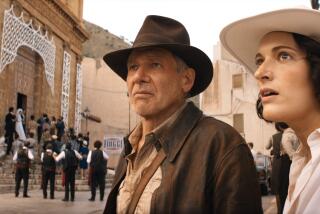Emmys 2016: VR makes a (small) stand
When the Emmys telecast get underway Sunday night, it will honor the best that traditional entertainment has to offer, from network-based shows like “Game of Thrones” to streamed programs such as “Transparent.”
But a small bit of TV history was made recently when a piece of virtual-reality content became the first original work in the medium to snag an Emmy.
“Henry,” a Pixar-like short about a lonely porcupine, won the prize for original interactive program at the Creative Arts Emmys which were handed out Sept. 10. The piece, from VR giant Oculus’ Story Studio division, allows the user to live inside the world of its title character as he seeks to establish companionship over the course of his birthday.
Much of the piece feels like the kind of CG animation one would see on a movie-theater screen — wordless character-based storytelling, told in miniature and with vivid bursts of color. Only because it’s in VR, the action is unfolding all around the viewer, and even changes subtly depending on how one looks around in it. (We chronicled the production of the short here.)
“I think it’s a milestone for the medium,” Saschka Unseld, who heads up Story Studio, told The Times in an interview after the win. “Of course, it’s not in the context of television unless you’re in a [specifically] TV category. But it’s competing with all the interactive TV out there, and I think it’s massively important. It’s the next stage in the exposure of VR.”
The Emmys win indeed marks a sort of new Hollywood step forward for the headset-based medium. A nonoriginal VR piece — a marketing offshoot of the Fox series “Sleepy Hollow” -- previously won an Emmy, in the category of user experience and visual design. But never before has a VR piece conceived exclusively for the medium won an Emmy — or any other major Hollywood award, for that matter.
The Television Academy added the interactive category in 2013 in recognition of new, tech-based forms of storytelling. But until now the winners have mostly been offshoots of traditional television. A John Oliver “Last Week Tonight” piece won last year.
Whether awards bodies continue to add categories as more VR content is created — and which they would add if they do — remains to be seen.
“One fascinating thing right now is that we don’t know what these new categories are going to be,” Unseld said. “Are we going to have awards broken down by genre, like comedy and drama? Or maybe it’s different levels of interactivity? Or maybe VR pieces with characters and VR pieces that are experiential?”
With the new chapter come a number of more philosophical questions as well.
In its brief life to date, narrative virtual-reality — known in the industry as cinematic VR — has never been clearly categorized on the spectrum of traditional entertainment. Is it game content with filmic qualities? A movie with more participation? Something new and different completely?
The Emmy won’t necessarily clarify that — in part because the VR industry itself is still figuring how closely it wants to hew to old narrative structures.
But it shows that, when VR creators are mimicking the flat-screen entertainment people know, the industry pays attention. A new VR piece by Hollywood filmmaker Doug Liman, for instance, has been garnering attention, including an event at the recent Toronto International Film Festival.
“By having a foot in the old world, we want to bring in new people who didn’t even know they wanted VR,” Unseld said.
One wouldn’t want to get too comfortable putting anything in established categories, though: Story Studio’s next piece is “Dear Angelica.” It’s a tale with a mother-daughter relationship not dissimilar to what one might see on TV or at the movies — only by allowing the viewer to essentially live inside an artist palette it’s not exactly like anything HBO or Disney would do either.
See the most-read stories in Entertainment this hour »
On Twitter: @ZeitchikLAT
More to Read
Only good movies
Get the Indie Focus newsletter, Mark Olsen's weekly guide to the world of cinema.
You may occasionally receive promotional content from the Los Angeles Times.











